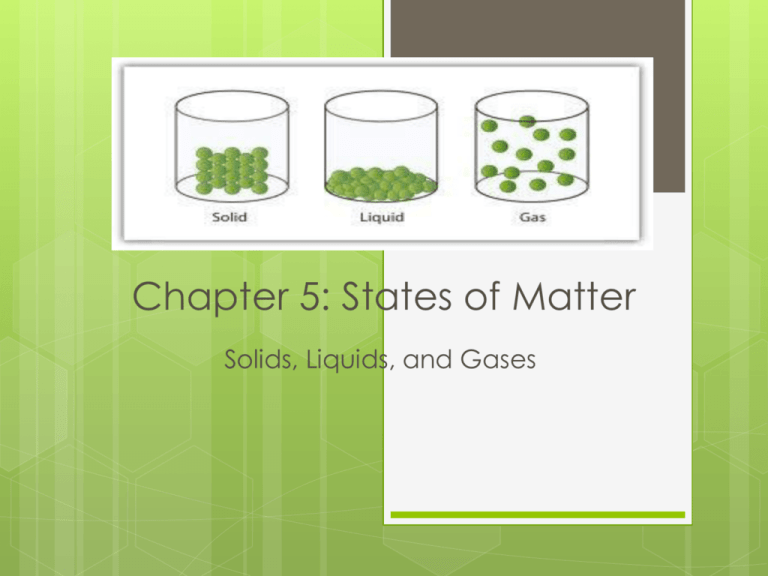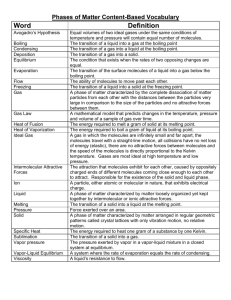Chapter 5: States of Matter
advertisement

Chapter 5: States of Matter Solids, Liquids, and Gases Completed as a requirement for Maverick Physical Science 2013-2014 J.L, P.D Liquids A phase of matter that is able to flow but has a constant volume. Flows when any sort of force is added no matter how small the force. Atoms do not have enough energy to break away from each other. Usually less dense than their solid forms. Solids Solid is a phase of matter where the volume is constant. Atoms vibrate in place to maintain its shape. Molecules are held tightly together by intermolecular forces. Gases A phase of matter that will expand to fill its container. Gases are the least dense state of matter. Every molecule has enough energy to break away from its area. They are less dense because molecules are spread apart. Pressure A force that is distributed per unit. Putting force on an object creates pressure. Works in all directions, not just the area you pushed. Comes from the collision of particles. Melting and Boiling Point Melting point- the temperature of which a substance will turn from solid to liquid. Boiling point- the temperature in which a liquid turns into a gas. Melting and Boiling Point (cont.) Different substances have different melting and boiling points. For example: water boils at 100 degree Celsius and melts at 0 degree Celsius while oxygen’s melting point is -219 degree Celsius. Energy plays a big role for changing matter because it takes energy to overcome intermolecular forces. Melting and Boiling Point (cont.) Different melting and boiling points are essential to life because we need to use solids, liquids, and gases to preform different tasks. When you freeze a liquid to a solid, it becomes less dense. Organisms need to have certain gases to be room temperature in order to survive and get nutrients. Convection Convection occurs when matter expands and it becomes lighter so it heads to the top. Warm air moves up because it becomes less dense. Then, when it cools, it goes back down and repeats the cycle. The Atmosphere Air is 1000 times less dense than water. The air we breathe (a mixture of nitrogen, oxygen, and other gases) is the most important gas on Earth. As you go higher in the atmosphere, there is less pressure. Weather is created by the pending temperature. Mechanical Properties When you apply a force to the solid, it may change its shape or size. The strength of an object depends on its characteristics. Elasticity describes how much an object can be stretched and still return to its original shape. Brittleness is how easily the object can crack or break. Ductility describes how an object can be transformed into useful shapes. Intermolecular Forces Intermolecular forces are forces between molecules. States of matter exist because of this. When it is very hot, molecules overcome intermolecular forces and spread apart. Medium amounts of energy causes it to form into a liquid. Little energy makes the matter a solid. Intermolecular Forces (Cont.) One type of intermolecular is dipole-dipole attraction. This happens when polar molecules align themselves to maximize the positive negative attractions and minimize the positive-positive repulsions and negative-negative repulsion. Another form of dipole-dipole attraction is hydrogen bonding. This attraction occurs when a Hydrogen bond is covalently bonded to an atom with high electronegativity like Oxygen, Nitrogen, or Fluorine atom. The last type of intermolecular force is London Dispersion Force which occurs between non polar molecules like the noble gases. Evaporation Evaporation happens when molecules transform from liquid to gas below the point of boiling point. Evaporation varies about the average kinetic energy. High energy molecules are the source for evaporation. Energy is added when evaporation takes place because it needs energy to break bonds. Condensation Condensation happens when molecules transform from gas to liquid. Condensation helps keep the object stay cool and stay at its temperature. Dew and fog are part of condensation. Contains water vapor and causes humidity. The Water Cycle The water cycle is a repeating cycle that recycles water for us to use. This is the reason why Earth does not run out of water. Parts of the water cycle includes condensation, precipitation, and evaporation. Polymers Materials in which molecules are individually made of long chains of repeating units. Plastics and amorphous solids are polymers. They are useful because they have melting points in room temperature and can be formed into solids using molds. Heat Conduction in Solids Heat conduction is the transfer of heat when two particles touch. Conduction occurs between two materials at different temperatures when they are touching each other. Thermal Conductors and Insulators Solids are the best conductors because they are close together. Gas is a poor conductor of heat because molecules are far apart where there are few collisions. Materials that conduct heat easily are called heat conductors. Materials that conduct heat poorly are called thermal insulators. Thermal Conductors and Insulators (Cont.) Silver, copper, gold and aluminum are examples of thermal conductors. Conduction cannot occur anywhere where there is no matter. A thermos is a bottle that is surrounded by a larger bottle. Air molecules is removed from space between the two bottles to create a vacuum. [Insulator]








